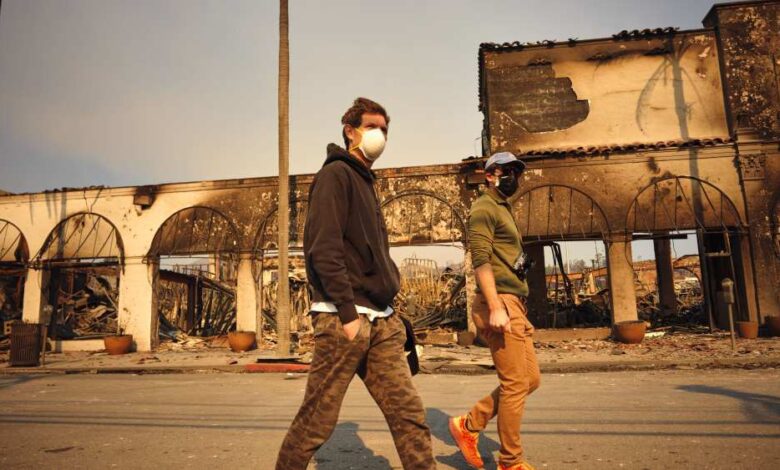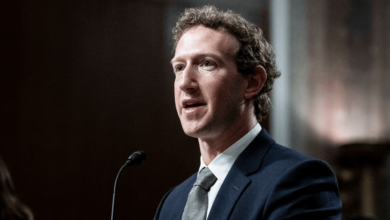How climate change fueled LA’s devastating wildfires

Climate change did not cause the wildfires that are ravaging Los Angeles County this week. But the wide swings in weather patterns that have accelerated over the past two decades are serving as rocket fuel that intensifies the flames and spreads the destruction.
Environmentalists and scientists warn that Southern Californians will have to face harsh truths in the wake of the horrific firestorms in Malibu, Pacific Palisades and Altadena. The extent of the damage will impact every industry operating in the region – and no amount of velvet ropes, basement bunkers or private fire brigades will spare Hollywood.
“This is not going to go away tomorrow,” said Debbie Levin, who has been CEO of the Environmental Media Association for 25 years. “There will still be climate change. We’ve had an industrial world since the early 20th century, so this has been going on in our atmosphere for over a hundred years, and we’re dealing with it now. For some reason there is still blindness as to how local communities should deal with this.”
Wildfires are a natural and even necessary part of the region’s desert ecosystem. Human pain and suffering is compounded by more than a century of extensive housing development in areas prone to fire, mudslides, drought and unpredictable amounts of rain and snow. And all this is made worse by the effects of greenhouse gases in the atmosphere that are causing climate change around the world.
“Here’s the paradox: Climate change is human-induced and is making fire season much worse,” said Stephanie Tweecetl, a professor at the UCLA Institute of the Environment and Sustainability and founding director of the school’s California Center for Sustainable Communities. “While we have always had a fire season – these places have burned in the past – the extreme weather has accelerated. Hotter hot, drier dries, wetter wet, colder cold.”
RELATED CONTENT: Devastating fires leave LA residents looking for luxury homes in a tight market: ‘Get Me to Newport’
The situation that broke out in Los Angeles’ hotspots was unfortunately predictable, she adds.
“The combination of very, very dry vegetation and extremely high winds meant that any inflammation that occurred in that ecosystem would spread very quickly,” says Pincetl.
Monalisa Chatterjee, a professor of environmental sciences at USC, echoed Pincetl’s sentiments.
Strong Santa Ana winds are normal for Southern California, in part because the region has an unusual combination of mountain ranges that run north and south and east and west. But even for Santa Ana conditions, the 80 and 90 mile per hour winds recorded at this week’s hotspots are unprecedented. The timing of these conditions in Santa Ana in early January is also unexpected. As one expert put it, the situation that broke out on January 7 was essentially a hurricane, but with fire instead of rain.
“Santa Ana wind events are quite common in this location, but of this magnitude – this is an unprecedented event that we are experiencing,” Chatterjee said.
The extreme weather events in Southern California in recent years have wreaked havoc. In 2021 and 2022, the Los Angeles area was pummeled by heavy rainfall, putting vegetative growth on hillsides, canyons and forest areas on steroids. The drought that returned in 2023 and 2024 turned these areas into parched tinderboxes waiting to ignite.
“Every kind of extreme situation has overlapped in this one moment,” Chatterjee says.
For scientists and activists, the fact that climate change in the US has become a highly politicized issue in times of crisis is infuriating. Tweecetl and Chatterjee both denounced the blame game that ensued this week, amid the fear and loss. The problem is bigger than the capabilities and resources of any fire department.
“You simply cannot have enough firefighters on the ground to control something that is this violent, and with the winds that we have experienced. And all the finger pointing starts. “Oh, it was DEI in the fire department,” says Pincetl. ‘Or: ‘The fire brigade didn’t have enough money.’ Even if the fire department had more money, there would not have been enough resources to fight these fires. It wasn’t [immediately] manageable. We just need to become more accepting of the fact that we have unleashed forces beyond our control. And the real finger-pointing that should be happening is at the oil companies and the continued dependence on fossil energy, which is disrupting the climate.”
This week’s devastation will be felt across the region for years, possibly decades. It should serve as a wake-up call.
“I think through this process we will discover that there are opportunities to get to grips with a changing climate that weren’t there before,” says Pincetl. “We may not rebuild some of the most egregiously high-risk homes.”
The EMA’s Levin sees this moment as an opportunity to develop an intellectual approach to mitigating future risks – if the political will is there among local leaders.
RELATED CONTENT: Disney and Paramount Donate to LA Fire Relief and Reconstruction Efforts, CAA Launches SoCal Fire Fund
“The oceanfront homes in Malibu won’t be able to be rebuilt. There has been such erosion because of what has happened in the climate that the Coastal Commission will not let them build,” Levin notes.
Unfortunately, the political debate surrounding climate change and policy decisions affecting businesses and homeowners will make the process of recovery and risk mitigation more difficult in the long term. “People are starting to blame the wrong things. I’m afraid we’ll hear more about, “Why weren’t services better?” and ‘Why doesn’t my insurance cover me?’ conversation,” says Levin.
Chatterjee points to the long-term increase in non-native flora and fauna in the region. Plants, grasses and trees that do not naturally occur in desert climates tend to burn more quickly and at higher temperatures, while native plants tend to be more resilient.
“In many cases we are far away from native species that are fire resistant and therefore don’t burn as much and are able to survive even when there are high temperatures and fires,” says Chatterjee. “But then we switched to invasive species that are perhaps more beautiful. We placed them in our environment because they look nice. But from a fire perspective they are very bad because they burn easily and then help spread the fire.”
One of the immediate concerns is the danger of a huge amount of pollutants flying through the air and seeping into the ground. Modern homes are full of plastics, chemicals and other synthetic materials that emit toxins when burned. That is why residents of the worst affected areas are ordered to boil water before consuming any.
“We have so many things that are not natural in our homes. We have so much plastic in our homes and we have different types of chemicals,” Chatterjee explains. “When all those things burn, and those things also turn into ash, all that toxic material ends up in our air that we end up breathing, which ends up exposing us to a lot of things. It breaks it down, burns it, making it even more toxic, and then it ends up in the environment.”
Levin believes Hollywood and storytelling can play a role in helping the general public understand the practical realities of climate change. The EMA has been advocating for years that writers and producers seek out hopeful stories that show how incremental changes – such as banning the use of plastic shopping bags, which the EMA strongly supports – can make a difference. There is no shortage of apocalyptic visions of the future. It’s high time that one or two climate scientist heroes are shown on TV and in movies in ways that can educate and inspire.
“You have films and TV shows about climate disasters that show how bad it can be,” says Levin. ‘But usually they don’t discuss what we should do next. And that’s a problem because if it’s all catastrophic, people turn away from it or see it as a threat to people who don’t believe in climate change.”
RELATED CONTENT: LA reporters report devastation in their own neighborhood during wildfires: ‘feels like a nightmare’ and ‘fatigue is setting in’
Tweecetl and Chatterjee argue that a series of decisions lie ahead for Southern California residents as well as political and business leaders. This week’s firestorm will likely convince some people to leave the Golden State entirely.
“We cannot stop climate change because there are so many greenhouse gases in the atmosphere. So we have to make some decisions,” says Tweecetl. “Are we going to continue to create the conditions for even greater climate disruptions and continue to try to promote the status quo of our lifestyle through work arounds? Or are we going to face the fact that the world has changed and we need to change the way we build and where we build and the way we move and so on? I just don’t see any other solution.”
Despite the political winds in the US and newly elected President Donald Trump’s history of denying and exacerbating climate change problems, evidence is mounting in cities and towns across the country that the risks from erratic weather patterns are only increasing. There is a path forward for Southern California if key stakeholders embrace the urgency of the situation, according to key experts.
“Climate change is making it drier and hotter. So the risk of wildfire is not going anywhere,” Chatterjee said. “We have to be smart about how we live in this environment, where we live, what kinds of choices and decisions we make, how we manage our fuel and how we communicate about these risks. There are many adjustments and adjustments that we must take into account if we want to continue living in this environment.”
(Image: Two unidentified people walk through a fire-scarred area of Pacific Palisades on January 10, 2025)




